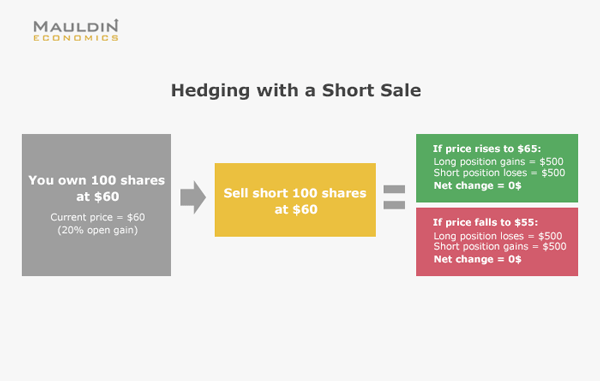Mauldin Academy
Short Selling 101: How to Short a Stock and Make Money As It Falls

Short selling can be a powerful tool in your investment toolbox, but you need to understand the operator’s manual before you use this tool. Try to short a stock the wrong way and you could drill a hole in your own hand.
What is short selling?
Every investor understands the conventional way to make money in the stock market (if they don’t, they shouldn’t be in the market!). You buy a stock today, wait for its price to go higher than you paid, and then sell it for a profit. This is known as being “long” the stock. Pretty straightforward.
Short selling is the same process in reverse. You sell a stock today, wait for the price to fall below what you paid, and then buy it at a lower price. This is known as being “short” a stock, or short selling. Sounds a little weird and complex at first, but it’s actually rather simple to do as I explain next.
________________________________________________________
When you are long a stock, your goal is to buy low and sell high.
When you are short a stock, you want to sell high and buy low.
________________________________________________________
How do you sell a stock you don’t own?
The quick answer is you borrow the stock.
How do you do this? Your broker will locate shares for you to borrow. In fact, many brokers require you to borrow shares before they will accept your short sell order.
When your broker fills a short sell order for you, another investor agrees to buy the shares from you. It’s your responsibility to deliver the shares to the broker by settlement date—normally three business days later.
The graphic below makes it easy to grasp the procedure.

This raises another question: why would an investor loan their shares to you? How do they benefit? The answer: You will pay them interest, giving them an extra return on their shares.
Large pension funds, mutual funds, and brokerage companies love to lend out their shares in this way. It’s easy, low-risk money for them.
Why short selling?
Investors sell short for three main reasons:
- To speculate that a stock’s price will fall
- To hedge a long position in the same or similar stocks
- To seek favorable tax treatment
Let’s look a little closer at each of these strategies.
Speculation
Speculation is the most common reason to short a stock. If you think the market has overvalued a company, or you anticipate negative events or company news that will impact the stock, a short position gives you a way to make money—assuming your outlook is correct, of course.
Successful speculation requires solid research, good intuition, and excellent timing. Historically, the stock market has an upward bias. That means short sellers have to swim against the tide. But if you short a stock at the right time, you can make a bundle.
Hedging
Hedging is another reason investors will short a stock. In this context, a “hedge” acts as insurance. It’s an investment position that protects you from some kind of potential loss.
For example, suppose you own shares of Company A as a long-term hold. Maybe you depend on the dividends for your retirement income. You’re worried that the approaching quarterly report might disappoint analysts and other shareholders and send the stock price lower.
What you can do is open a short position for the same number of shares you already own. This will effectively “lock in” today’s stock price for you. If the share price falls, your short position will rise by the same amount. If the stock rises, you will lose on the short side but that will be offset by the shares you already owned. This technique is called shorting against the box.

Once the quarterly report is released and the uncertainty is gone, you’ll close out the short position. You will probably have lost a small amount of money, but you will have gained peace of mind.
In one sense, hedging is similar to the fire insurance you buy on your home. The premiums don’t go to waste just because your house didn’t burn down. You paid for protection and you enjoyed having it.
Favorable tax treatment
Tax considerations are another reason to short a stock. For example, let’s say you own a stock that has risen in value. You’re happy with the current price and would like to sell. However, you can save on taxes if you wait another six months to sell so it will be a long-term capital gain.
While you could short against the box as in the hedging example above, in 1997 the IRS decided not to let people defer taxes in this way. However, you can short another stock from the same industry, or an ETF representing its sector. It would not be a perfect hedge but might still accomplish your goal.
(Before any transactions are made for tax reasons, consult your CPA or other tax professional to discuss if it is appropriate for your circumstances.)
When to Consider Shorting a Stock
Short selling requires excellent timing. While you can theoretically keep a short position open indefinitely, the interest and opportunity costs will add up over time.
More important, when you short a stock you are in an asymmetrical risk position. Your maximum gain in a short selling transaction is 100%, and that would only happen under extreme circumstances where the company stock price falls to zero.
At the same time, your maximum risk is unlimited. A stock can go infinitely higher... and the higher it goes, the more money your short position will lose.
For this reason, you only want to short a stock when you have good reason to think it will fall in price soon. Situations like this can include:
Failed takeovers
When one company offers to buy out another, it is often conditional on shareholder approval, regulatory clearance, or other issues being resolved favorably. Any rally in the stock price following a takeover announcement can quickly reverse if the deal falls through.
Earnings disappointment
Companies announce financial results quarterly. If the news matches analyst estimates, the stock usually shows little reaction. A “miss” on expectations can send shares down quickly. If you believe that bad news will be announced, hedging these scenarios is simple because you know when results will be released weeks in advance.
Product flops
If a company’s future depends on a new product’s reception, the stock price is vulnerable to customer disappointment. Make-or-break product launches are a high-risk time for any company.
Key Rules to Avoid the Most Common Pitfalls

CNBC commentator and former hedge fund manager Jim Cramer recently published 6 vital rules to short selling. Here’s a quick summary:
- Never short a “best of breed” company. When a company is getting lots of positive headlines, shorting it is risky. Better to focus on unpopular companies.
- Ask yourself if the company could draw a takeover offer. Troubled companies with valuable assets can draw takeover offers that send the price soaring. If a company fits that profile, don’t short it.
- Never short a stock because it “seems overvalued.”Never underestimate the irrationality of bulls. A stock that everyone thinks is ridiculously overvalued can get even more so.
- Don’t short with common stock if put options are available. Unlike an actual short position, options can let you take a bearish position with limited risk.
- Never “gang up” on a stock with other short sellers. You can’t be sure the rest of the gang will stick around. They can exit the trade lickety-split and leave you holding the bag.
- Don’t be afraid to hold cash when uncertain. Markets can go sideways for extended periods. Only short a stock when you have high confidence it will fall in price soon.
How to place a short sell order
The process of shorting a stock is simple. Here is what you do.
Step 1: Open a margin account at a brokerage firm.
- If your account doesn’t have margin, ask the firm to add it. Your broker will send additional disclosures and ask you to sign a margin agreement.
- “Margin” means you have enabled your account to borrow cash or stock from your broker. This feature also allows you to buy a stock “on margin,” i.e., with cash loaned to you by your broker.
- Short selling and buying on margin are both riskier than normal stock investing.
- Regulations require your broker to make sure your financial condition leaves you prepared for the risk, so your broker may ask you some probing questions about your income, assets, etc. Individual Retirement Accounts and other kinds of tax-deferred accounts are not eligible for margin. You will need to open an individual, joint, corporate, or trust account to hold your short transactions.
Step 2: Enter your order to sell short
- Most online firms will have a “short sale” box to check on their order entry screen. This is different from selling a stock you already own, so be sure to pick “short sale” instead of just “sell” order.
- Brokers vary on borrowing policies. Some will ask you to verify that shares are available to borrow before you enter the trade. Others will check automatically and reject your trade if they don’t have the shares you want in inventory. Ask a representative how it works if you aren’t sure.
Step 3: Follow this same process when you are ready to close out the short trade.
- Instead of picking “short sale” for your order type, you will “buy to Cover.” This is different from buying shares you intend to hold.
- The “to cover” part tells the firm that these shares will replace the ones you borrowed, and your short trade is closed.
Short selling risks and limitations
The biggest risk when you short a stock is that its price could go higher. Each dollar higher will make your short position lose value by the same amount. If the stock doubles in price, your short position will be at zero. Your broker will then require you to reimburse the firm for the shares you borrowed.
Infinite losses
Always remember a short sale position has limited reward and unlimited risk. It is completely possible to invest $5,000 and lose $10,000. That probably won’t happen because the broker will step in and liquidate your position, but it is a possibility. Never “short and forget.” Monitor your short positions closely.
Short squeeze
A “short squeeze” is another big risk. Short sellers must buy shares when they exit their position. If too many people do this at once—say, because the stock just fell sharply—the stock price can spike higher and start a kind of domino effect. More short sellers will enter buy-to-cover orders and drive the price higher still.
Margin call
Another risk is a margin call. Your broker can require you to deposit additional cash if the position goes against you. If you don’t, the brokerage can liquidate the position and bill you for any losses.
Restrictions on Short Selling
No “penny stocks”
Federal regulations also place additional restrictions on short selling. Generally, you can’t sell short in “penny stocks” (those trading under $5 per share). Regulators sometimes place additional restrictions in extreme market conditions. For instance, during the 2008 financial crisis the SEC temporarily prohibited short selling of banks and other vulnerable institutions.
The uptick rule
Short transactions also have to follow the uptick rule. The rule states that short selling is only allowed on an uptick, meaning a price above the last traded price. The rule is designed to prevent short sellers from further driving down the price of a stock that has fallen 10% in a session.
Regulation SHO
A 2005 rule called Regulation SHO cracked down on so-called “naked shorting.” This was a practice, common at the time, in which brokers would execute short transactions without already having shares to deliver. The resulting “failure to deliver” situations created market stress and disrupted normal trading.
If you are in a short position and the stock pays a dividend, you will have to reimburse the shareholder from whom you borrowed the shares. Normally your broker will require you to have cash in your account for this purpose.
Alternatives to Selling Short
Shorting a stock is not the only way to bet on falling share prices. Other instruments can accomplish the same or similar goals.
Put options
Put options give you the right to sell shares at a defined price for a defined length of time. You pay a premium when you buy the option. If the share price is below the “strike price” on expiration day, you get to keep the difference. If it is above the strike price, the put option will expire worthless and you will lose all your premium.
Single stock futures
Single stock futures work much like other futures contracts. You promise to buy or sell shares of the stock on a future date. You only have to post a small deposit with the futures broker, so the leverage in futures can be substantial. They are only appropriate for sophisticated investors with experience in futures trading.
Inverse ETFs
Inverse ETFs are funds designed to track a market or sector index in reverse. The ETF will rise in value as its underlying index declines. These can be very useful if your assets are in an IRA or you otherwise don’t have margin ability. The downside is you cannot bet on a single stock’s decline. You have to look at an entire market or sector at once.
Conclusion
Short selling can be a very useful tool for individual investors who use it wisely. Shorting a stock gives you a chance to earn a profit even when the stock price falls. Every investor should be familiar with short selling and know how to use it in the appropriate circumstances.
Like all active trading strategies, short selling can be risky. Before you try it, make sure you are prepared for potential losses and that you have an exit strategy. Decide in advance what you will do if the trade goes against you.
You should also have a profit target. Remember, the most you can make in an unleveraged short sale is 100%, and that is very rare. Decide on a reasonable return and close out the trade when (and if) you get there.


